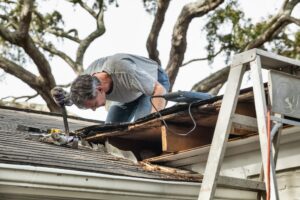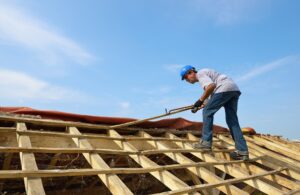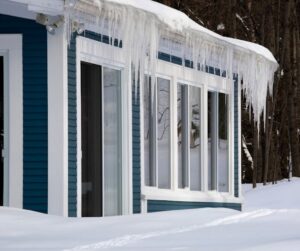Frozen precipitation can wreak many kinds of havoc on homes, including roof damage. Heavy piles of ice and/or snow can overburden your roof’s weight capacity, cause key components to leak, and leave your roof with damaged gutters or shingles. Without a strong, intact roof, your home may experience even worse damage from the next storm.
Once you know what kinds of roof issues to watch out for in the aftermath of a snow or ice event, you can catch those problems as soon as they occur and then contact your roofing services company for prompt, effective repairs. Pay particular attention to the following four potential roof threats.
1. Heavy Accumulations
Both snow and ice can add considerable weight to your roof. Even light, fluffy snow weighs about three pounds per square foot, with heavier, denser snow weighing closer to 21 pounds. A thick layer of ice can almost triple that weight, adding up to 57 pounds per square foot. This excess weight can sometimes cause roofs to collapse.
The age of your home may also determine how well your roof can stand up to heavy accumulations of ice and snow. If your home’s construction predates 1975, it may not have enough structural strength to withstand the 20 pounds per square inch commonly tolerated by newer homes.
Have a professional roofing team remove thick coatings of frozen precipitation from your roof as soon as you reasonably can. This response not only takes the immediate threat off of your roofing, but it also prevents the next accumulation from joining this one and raising the risk of damage.
2. Ice Dams
As ice and snow on your roof warm up, it naturally starts to melt and drip down the slope of the roof toward the gutters. Unfortunately, it may freeze up again before it actually passes down the gutter system or drips off of the roof. Roofers describe the resulting masses of heavy ice and overhanging icicles as ice dams.
Ice dams often occur when interior attic temperatures force ice to melt in spite of sub-freezing outdoor temperatures, causing rapid warming followed by rapid re-freezing. They can do considerable harm in the form of loose shingles, damaged gutters, and backwash that can leak through the roof and into your attic.
Effective strategies for preventing ice dams involve adding thermal insulation to your attic, closing any hatches or gaps that ventilate warm air, and adding ridge and/or soffit vents that circulate cold air. If you already have ice dams, your roofing expert can remove the ice dams safely and gently without damaging your roof.
3. Leaky Flashing
A sturdy roof with a fully- intact set of shingles may still harbor a weak link: the flashing that seals the joints around your chimney and vents. These thin strips of metal normally make these joins watertight. However, the stresses of ice and snowstorms, weakness in the sealant that holds the flashing in place, or incorrect installation can promote leaks.
Have your flashing inspected after they’ve endured an ice or snowstorm. Even in calm weather, you’ll want to have the flashing inspected every six months, replacing worn or aged flashing as needed.
4. Shingle Loss or Damage
As heavy accumulations of slush and ice slide off of your roof, they can sometimes take shingles with them. This lack of protection leaves the roof’s underlayment vulnerable to even more severe damage than it may have already sustained. If you see evidence of missing shingles, get those shingles replaced immediately.
Melting ice or snow can remove shingles of their protective granules, limiting their ability to resist both fire and UV rays. Even shingles that retain their granules may show signs of splits or cracks that limit their ability to do their job. Replace those shingles before the next bout of foul weather comes along.
Precise Roofing & Contracting can help your roof survive snow and ice storms for many years to come. Contact us today.





